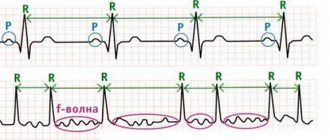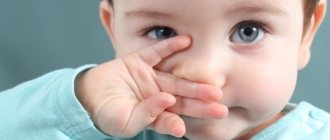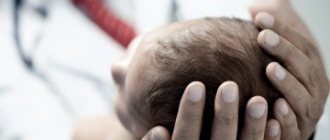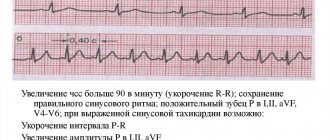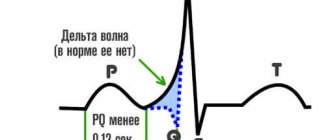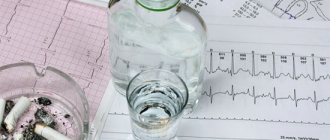Signs of tachycardia
The heart of babies does not beat in the same rhythm as that of adults: the pulse in children is different from the pulse of adults. This is due to the structure of the baby’s body, which is in the process of rapid development and growth. If the norm for a mature organism is a pulse of 70 beats per minute, then the heart of a newborn beats twice as fast - 159 beats per minute. By the age of two, the heart rate changes - up to 123 beats per minute.
Rapid heartbeat in a child is a relative concept. To correctly determine the presence of pathology, you need to check the readings with the table:
- from 1 month to a year: from 110 to 170;
- from one to two years: from 94 to 125;
- from two to four years: from 90 to 125;
- from four to six: from 85 to 120;
- from six to eight: from 78 to 120;
- from eight to ten: from 68 to 106;
- from ten to twelve: from 60 to 100;
- from 12 to 15 years: from 55 to 95.
After fifteen years, the heart rate comes into line with the adult norm - from 65 to 90 beats per minute. A heart rate above that indicated in the table is considered a pathology. Doctors define two types of tachycardia – physiological and pathological. That is, in some cases, a rapid heartbeat is beneficial (physiological), and in others it is considered a deviation. Why is this happening?
What causes heart palpitations?
Rapid heartbeat is very common in children and is not usually associated with heart problems or congenital heart defects. Common causes of tachycardia are:
- emotional stress and anxiety
- significant physical exhaustion (not being in good physical shape)
- asthma medications
- carbonated drinks and other caffeinated foods or drinks.
Young children often report palpitations as chest pain because they are unable to describe their complaint in appropriate words. In some rare cases, palpitations may be a sign of an underlying medical condition, such as a thyroid problem, low levels of hemoglobin in the blood (anemia), or a cardiac arrhythmia (an abnormal heart rhythm most often associated with rapid heartbeat and heart rate).
Physiological tachycardia
The heart can beat fast for many reasons, such as:
- elevated temperature;
- physical stress;
- too hot air;
- taking certain medications;
- painful sensations.
An increase in heart rate and temperature in a child is a natural reaction of the body to illness. This condition is not considered a pathology and goes away with healing. In case of colds and other diseases, the body increases body temperature to expel germs and viruses: that is, it creates unfavorable conditions for them.
What happens when the body temperature rises? The immune system works in “combat mode”, blood flow and heart rate increase, as the task is to expel foreign elements from body tissues. At the same time, the pulse and heart rate naturally increase.
Table of increased heart rate at temperature:
- 1-2 months: from 154 to 194;
- 6 months: from 148 to 187;
- 1 year: from 137 to 176;
- 2 years: from 125 to 159;
- 3 years: from 120 to 152;
- 4 years: from 115 to 145;
- 5 years: from 110 to 139;
- 6 years: from 105 to 131;
- 7 years: from 99 to 125;
- 8-9 years: from 95 to 119;
- 10-11 years: from 95 to 117;
- 12-13 years: from 90 to 114;
- 14-15 years old: from 86 to 108.
After procedures aimed at reducing the temperature, the fever gradually subsides. If the tachycardia does not go away and the rapid heartbeat continues, it means that the body cannot cope with viruses. However, we may also be talking about a previously hidden pathology:
- heart disease;
- inflammation of the heart muscle.
If the increased heart rate is not due to a cold, but due to irritating factors (heat, overexertion), then after they are eliminated, the heart rate quickly returns to normal. In adolescents from ten years of age, a rapid heart rate is a sign of changes in the body and goes away on its own.
Important! Also pay attention to an important feature: with a physiological increase in heart rate, the rhythm of heart contractions is always smooth.
In pathological processes in the heart, the rhythm of contractions is inconsistent - the heart beats intermittently and stops.
Frequent heartbeat in a child with fever
If in adults a heart rate of more than 120 beats per minute is considered a sign of tachycardia, then in children the norm is much higher, and with age the threshold gradually decreases, reaching a constant value around the 12th year of life.
Nominal heart rate indicators depending on age:
- for newborns, the norm is 140–160 contractions per minute;
- for six-month-old toddlers – 130 – 135;
- in one-year-old babies – 120 – 125;
- by 2 years the heart rate rate decreases to 110 – 115;
- at 3 years old, a child’s normal heart rate is 105–110 beats per minute;
- for a five-year-old child the norm is 100 – 105 contractions per minute;
- at 8 years old – 90 – 100;
- at 11 years old – 80 – 85;
- from the age of 12, the heart rate is set at the “adult” level – 70 – 75 beats per minute.
An abnormal condition is considered to be a condition in which the child’s heart rate exceeds the norm by the following values:
- 10 – 20% – tachycardia degree I (moderate);
- 20 – 40% – tachycardia degree II (average);
- 40 – 60% – third degree tachycardia (pronounced form).
Sinus tachycardia in a child occurs as often as in adults, and in most cases, a short-term increase in the frequency of cardiac contractions is the result of excessive physical or emotional activity, that is, the body’s natural reaction to an increase in oxygen demand. But if such conditions occur frequently and without reason, or last for a long time, this is a reason to consult a doctor to identify possible abnormalities in the development of the cardiovascular system.
Reasons for the formation of childhood tachycardia
Tachycardia in children is a condition that is not an independent disease. Doctors consider an increase in the frequency of myocardial contractions either as a normal variant or as a symptom of a systemic disease (heart failure, central nervous system pathology, abnormalities in the functioning of the left ventricle, disease of the hematopoietic system).
If a child finds himself in a stressful situation that leads to the release of adrenaline, being in conditions of oxygen deficiency, high ambient temperature are factors that can provoke a rapid heartbeat.
Infantile tachycardia is often observed when taking certain medications, drinks with high caffeine or alcohol content, and even when changing body position (when starting to walk after prolonged sitting or lying down).
Mild tachycardia in children is also observed in diseases accompanied by fever, in fainting states, when children experience nervous shock.
An increase in heart rate in children can be caused by other reasons:
- the presence of cardiopathy;
- with congenital heart disease (usually detected during pregnancy);
- in the presence of murmurs in the heart area;
- the child has hyperthyroidism;
- when the body is dehydrated.
Symptoms of tachycardia in children are usually divided into physiological (arising as a result of exposure to external factors) and pathological, developing against the background of abnormalities of the body. The latter can also be observed at rest - they are the ones who deserve special attention from parents.
Forms of childhood tachycardia
Moderate tachycardia in a child is most often perceived as normal. But if attacks of increased heart rate occur frequently, for no apparent reason and are of a pronounced nature, this may indicate the presence of a pathology, which can take two forms:
- sinus infantile tachycardia;
- paroxysmal tachycardia.
The sinus type of tachycardia means that the sinus node, which is responsible for generating impulses that trigger myocardial contractions, does not work correctly, generating unnecessary electrical impulses. The second cause of this type of tachycardia may be various conduction disturbances along the sinus node-ventricles route.
Increased automatism of the sinus node in newborns causes an increase in heart rate and is usually not considered a pathology.
In adolescence, the sinus type of heartbeat abnormality can also be provoked by physiological factors:
- acceleration (increased growth of a young organism);
- physical fatigue;
- emotional disorders.
The main pathological reason for the formation of sinus tachycardia is pathology of the cardiovascular system or endocrine abnormalities.
Paroxysmal tachycardia in children refers to pathologies characterized by a sudden increase in heart rate and the same unexpected end of the attack.
Pediatric paroxysmal tachycardia is divided into two types:
- Ventricular, observed in childhood, is relatively rare. Ventricular gastric tachycardia is characterized by the production of additional impulses in the ventricles and, if untreated, can be life-threatening.
- Supraventricular, or supraventricular tachycardia, in which impulses responsible for increasing the heart rate are formed in the atrium. Typically, this type of pathology occurs frequently, starting in infancy, and the duration of attacks can last from several minutes to 1 - 2 hours.
Symptoms
Recognizing tachycardia in children, especially infants, is quite difficult, since the external manifestations of this pathology do not have pronounced features inherent in this particular condition. The most characteristic symptoms of tachycardia in children:
- fast fatiguability;
- dizziness;
- pain in the chest area;
- dyspnea;
- frequent fainting.
Of course, complaints about increased heart rate are already clear evidence of an abnormal heart rhythm, but babies certainly won’t tell about it. Therefore, tachycardia in a newborn child can be detected only by indirect signs, and parents should regularly check the pulse rate, knowing about the normative indicators for this age group.
Strictly speaking, attacks of tachycardia in children under 1 year of age are considered normal; as a rule, children do not pay attention to such conditions. But if they occur frequently, this is a cause for concern.
Rapid heartbeat in children over 7 years of age may indicate the appearance of serious abnormalities, signs of which may include:
- feeling of heaviness behind the sternum;
- pain in the heart that occurs during an attack;
- nausea with dizziness, often accompanied by fainting.
Such severe symptoms may indicate problems with the blood supply to organs in the sinus form and circulatory failure in the case of paroxysmal tachycardia.
Diagnosis of childhood tachycardia
In some cases, tachyarrhythmias in children are asymptomatic, and such conditions are detected during a clinical examination.
To clarify the diagnosis, the following methods are used:
- An ECG provides the opportunity to obtain data on the rhythm of cardiac contractions even in newborns, therefore an electrocardiogram is considered the primary and most accessible research method;
- daily monitoring (Holter) is also suitable for use at any age, this method allows you to obtain more informative data on the work of the heart over 20 - 24 hours;
- Echo CG is a procedure that allows you to determine the presence of sinus tachycardia, a potentially dangerous cardiac pathology;
- electrophysiological study makes it possible to determine the mechanism of pathology;
- an electroencephalogram is performed if it is necessary to exclude diagnoses such as diseases of the central nervous system and hematopoietic pathologies.
Correct and timely diagnosis of the disease is the key to eliminating cardiovascular problems in the future.
Treatment of tachycardia in children and adolescents
If an attack of rapid heartbeat is accompanied by severe symptoms, before the ambulance arrives, it is necessary to take measures that will alleviate the child’s condition:
- perform a light massage in the peritoneal area;
- cause an emetic effect in the patient;
- try to apply slight pressure on the eyeballs.
This first emergency home care usually stops an attack of sinus or paroxysmal tachycardia in children. If symptoms of rapid heartbeat are observed in a newborn, it is necessary to provide the baby with access to fresh air and place a cool towel on the forehead area. Before the doctor arrives, such simple procedures can reduce the symptoms of arrhythmia.
Older children can be given a few drops of Corvalol or Valocardin.
Drug treatment for childhood tachycardia is prescribed only by a cardiologist based on diagnostic procedures to determine the degree of pathology and the cause of its occurrence.
For stage II tachycardia, treatment for attacks consists of taking sedatives, medications containing valerian, dietary supplements and vitamin complexes.
The presence of cardiovascular problems is the basis for prescribing cardiac glycosides; when diagnosing anemia, glandular preparations are included in the treatment regimen.
Typically, pathological arrhythmia disappears after a course of treatment of the disease that caused disruptions in heart rhythm. In particular, high temperature during colds causes prolonged rapid heartbeat, and a drop in temperature automatically brings the heart rate back to normal.
Children over seven years old, when diagnosed with sinus tachycardia provoked by neurogenic factors, are prescribed sedative medications (Seduxen, Luminal). For the younger age group, homeopathic remedies will be most suitable.
Forecast
In most cases, childhood tachycardia is a condition close to normal. Typically, attacks last a short time and end without the need for intervention from medical personnel. But if the cause of the abnormal increase in heart rate is internal diseases, the success of therapy correlates with the treatment of the underlying disease.
Prevention of tachyarrhythmias in children
In order for your child to feel normal, it is enough to follow the following preventive measures:
- ensure that the child has a normal weight (obesity of any degree is an additional burden on the heart);
- active sports for tachycardia are undesirable, but as a preventive measure for pathology, physical exercise will not be superfluous;
- eliminate or minimize the consumption of caffeine-containing products;
- take care of a healthy diet, limiting the consumption of fatty foods and dishes based on quickly digestible hydrocarbons;
- maintain a calm regime at home and in a preschool (school) educational institution;
- Make sure that your child does not abuse alcohol and smoking.
If these recommendations are followed, attacks of tachyarrhythmias in the child will be minimized.
Source: https://detishki.ahuman.ru/chastoe-serdcebienie-u-rebenka-pri-temperature/
Pathologies of the heart muscle
Now let's look at pathological changes in the functioning of the heart. Tachycardia as a sign of the disease may appear in the following cases:
- heart disease;
- obesity;
- dehydration of the body;
- vegetative-vascular dystonia;
- anemia;
- thyrotoxicosis;
- cardiopathy;
- other pathologies.
Since young children cannot explain in detail what is happening to them, parents should pay attention to their child's condition. Symptoms of heart pathologies may include:
- sudden pallor of the child;
- swollen veins in the neck;
- the appearance of shortness of breath;
- sticky sweat on the skin;
- state of nausea;
- sometimes fainting.
If you find at least one of the listed signs, accompanied by tachycardia, urgently show the child to a cardiologist.
Normal heart rate during sports activity
All athletes, not just children, must monitor their health. The easiest way is to measure your heart rate before and after exercise. In this case, you need to especially pay attention to the frequency of the beats and their rhythm. It is obvious that there is a certain connection between sports activity and the number of heart beats per minute. The higher the load, the faster the heart beats. Calculation formula: (HRmax-NPP)* %HRmax+NPP
- HRmax – maximum heart rate according to the Roberges-Landwehr formula. 205.8-(0.685*age).
- %HRmax is the percentage of the maximum heart rate. 50-60% is a warm-up. In untrained people, such a pulse may appear during normal walking. 60-70% is the fat burning zone. At this time, the overall endurance of the body is developed. It is recommended to stay in it most of the time during training.
- 70-80% – aerobic zone or cardio zone. At this time, the stroke volume of the heart increases.
- 80-90% is anaerobic zone. Speed, strength and muscles increase.
- 90-100% is the competition zone. This is the maximum load zone. You shouldn’t let it get to this point, it’s simply unhealthy.
- RPP – resting heart rate. Measured immediately after waking up in the morning. As described above, subject to change.
Tables can be found on the Internet. In athletic children, the pulse is restored 10 minutes after stopping the exercise.
But the most important advice for parents is that parents need to monitor the child’s health. If unusual abnormalities occur, contact your doctor immediately. The child’s body recovers from illness quite easily, so even in serious cases, therapy usually ends in the child’s recovery.
First aid for a child
Heart attacks are not only common in adults; they also occur in children. Before the doctor arrives, you need to help the child and alleviate his condition:
- take it to fresh air or open a window;
- Place a towel wrung out from the water on your neck and forehead.
Important! You should not give your child medications: it is dangerous. Treatment can only be prescribed by a doctor.
Can heart disease in a child be cured? If the pathology is detected in time, the treatment outcome is positive in many cases. The baby will be prescribed a course of therapy, medication and exercises. In case of serious pathology, surgical treatment is necessary.
Pediatric tachycardia of a pathological nature is a serious reason to consult a doctor. Untreated pathology can result in serious complications that can lead to disability.
Causes of cardiac arrhythmias
The causes that lead to arrhythmia are divided into:
- Cardiac (cardinal) - congenital heart disease, heart surgery, myocarditis, vasculitis, rheumatism, pericarditis, heart injury, intestinal infection, tonsillitis, pneumonia.
- Extracardiac (extracardial) - prematurity during pregnancy, malnutrition in the womb, vegetative - vascular dystonia, anemia, endocrine system disorders.
- Mixed is when organic heart diseases and disorders of neurohumoral regulation (nerve impulses carried by blood and lymph) are combined.
Caring for a sick child
To avoid provoking new attacks of tachycardia, you need to do the following:
- provide psychological peace;
- reduce physical activity;
- monitor your daily routine;
- provide diet.
Parents should ensure that the child does not overexert himself physically and psychologically. Any stress, anxiety and negative emotions can cause an attack of tachycardia. Deep sleep is the main healer during illness. Make sure your child goes to bed on time and gets enough sleep. Physical activity must be alternated with rest, and the rest must be complete.
A diet for heart disease should exclude chocolate and strong tea, salty and spicy foods. Instead of tea, give your child compote made from dried fruits - it contains a lot of potassium and magnesium. These useful microelements are also found in baked potatoes - bake in their skins.
Symptoms
There are three degrees of the disease: moderate, severe and mild bradycardia. Each degree has its own heart rate and symptoms.
Light form
This degree is characterized by a decrease in heart rate to 60 beats per minute . A slow heart rate can occur in healthy people. The following factors may influence this:
- physical activity;
- hypothermia;
- dream.
Moderate degree
In this case, the child may not be bothered by anything. The baby's heart beats at a rate of about 50 beats per minute .
However, even with little physical activity, the child’s body will lack blood supply. The following symptoms may appear:
- fainting;
- dizziness when rising from a chair or bed;
- weakness;
- dyspnea;
- sleep disturbance;
- pain in the chest area;
- loss of strength and inability to perform any physical activity.
No less attention should be paid to this disease in adults. In the materials on our website, we wrote about the symptoms and treatment of the disease, the causes of its occurrence, bradycardia in athletes, and how dangerous it is for the fetus or pregnant woman.
Severe bradycardia
With severe bradycardia, fainting and falling often occur. This condition is accompanied by a decrease in heart rate to 40 beats per minute.
Can there be one-time manifestations? Yes, and this happens quite often. For example, if the child was very scared.
Bottom line
A rapid heartbeat in young children is a natural reaction to stimuli. The baby may be frightened of something or become very nervous, overheat in the sun or become overtired. Physiological tachycardia also occurs in adolescence, which is due to changes in the body.
However, physiological tachycardia must be distinguished from heart pathology. It usually manifests itself in sudden attacks and is always accompanied by an uneven heartbeat. Timely detection of pathology and active treatment will help the child become healthy.
Diagnostics
Diagnostic measures are based on collecting anamnesis. The specialist asks the child’s parents when their health worsened, how it was expressed, and what measures were taken.
This is followed by a physical examination:
- anthropometry;
- thermometry;
- auscultation and percussion;
- palpation.
If pathological changes in cardiovascular structures are suspected, screening examinations are recommended, namely:
- the frequency and rhythm of heart contractions can be easily observed on the ECG;
- 24-hour ECG monitoring is a safe and informative method;
- ECHO CG is performed to determine the nature of sinus disorder;
- blood tests allow you to determine endocrinological disorders, deviations in the parameters of glucose, hemoglobin, cholesterol;
- EEG allows you to exclude pathologies of brain structures.
Only the completeness of the information received by the specialist from the above diagnostic examinations allows him to conduct an adequate differential diagnosis and identify the true cause of the negative condition in the child.


